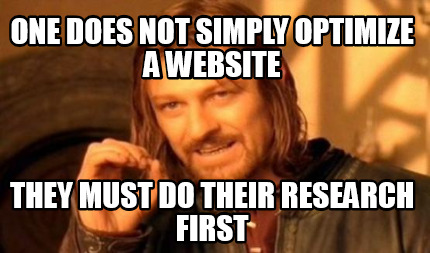
The first few months of any digital marketing campaign should be focused primarily on research. Unless you have already had a site audit performed, your digital marketing team will only have a cursory understanding of the issues involved with your website. And even if you have performed the audit, there can be a dilemma between fixing known site issues or plowing forward with new optimization.
Obviously, the goal is to get tangible results as quickly as possible, but fixing site architectural issues doesn’t necessarily get results. It just allows the other optimizations to be effective. And if you do the optimization, its effectiveness is hindered by the site architectural issues.
Ideally, the SEO would be able to focus on architecture issues simultaneously with optimization, but that isn’t always feasible based on what’s required and how much of the marketer’s time the client is paying for each month. Not to mention…

Which brings us back to my opening sentence. With the rare exception of clients with deep pockets, the first few months of an optimization campaign are often focused on research and fixing whatever issues are already known.
I think of the optimization and marketing of a website as similar to building a house. Before you can begin, there is a lot of work that must be done: Obtaining permits, developing plans, gathering approvals, and so forth. And then the foundation must be built. Skipping these steps might allow you to build your home more quickly, but it can get you into trouble later on.
Your first few months of digital marketing should focus on the following:
- Persona/KPI Interview & Questionnaire: Once we secure a client, we perform an interview with them, specifically to better understand their KPIs and the audience they are trying to reach. This information helps us to know how to most effectively focus their marketing campaign.
- Analytics setup: There is no point in having goals and KPIs if you can’t track them in an analytics package. We make sure analytics code is properly installed on the site and that the KPIs and goals are set up so everything can be properly tracked and assessed.
- Site audits: If the client needs, or requests, specific site audit reports, this becomes our starting point. If the report itself isn’t important, then we will audit on an as-needed basis rather than attempting to do them all up front. The report that typically accompanies an audit is just a way to compile all our findings in one place for easy reference. The report isn’t always necessary once engaged with ongoing marketing, but the data gives us plenty to work from.
- Topical keyword research: Almost every site can be broken down into a handful (or more) of topics. The most obvious example would be product categories (e.g., ski jackets, ski goggles, ski gloves) for a retail site. These topics will then be aligned with URLs for additional keyword research and optimization.
- Information architecture analysis & implementation: The architecture of a site is critical to the performance of all the marketing campaigns going forward. If the architecture is bad, the search engines and visitors will have trouble accessing the information. The development team should get to work right away fixing any issues uncovered.
- Navigation optimization: This isn’t something every site needs, but a lot do. After performing the keyword research, we will be able to assess whether improving the navigation will be valuable to the client or not. If so, we use the research to map out navigation changes for the site. Then, we send it to the client to review and approve.
- Social strategy/review: Taking time to review and assess the client’s current social media endeavors helps us develop a detailed plan for going forward. This review includes looking at competitors and mapping out what’s needed for a successful social strategy.
At the end of the sprint, we put together a benchmark report that outlines what we’ve done, assesses the performance data and provides the strategy for the next sprint. We don’t really expect the needle to move much due to very little actually being implemented. But the above list provides a strong foundation for moving forward with the marketing campaign, and accelerating the results to come.
